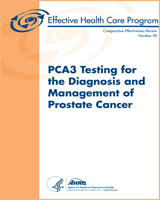NCBI Bookshelf. A service of the National Library of Medicine, National Institutes of Health.
Bradley LA, Palomaki G, Gutman S, et al. PCA3 Testing for the Diagnosis and Management of Prostate Cancer [Internet]. Rockville (MD): Agency for Healthcare Research and Quality (US); 2013 Apr. (Comparative Effectiveness Reviews, No. 98.)
This publication is provided for historical reference only and the information may be out of date.
- Study description and design, including:
- Country, institutions and enrollment period
- Enrollment number and flow of subjects through PCA3 and comparator testing, prostate biopsy, treatment and followup
- Source of funding and authors' disclosures of industry relationship(s)
- Blinding of index and comparator test results to pathologists and of biopsy/prostatectomy results to laboratorians conducting tests
- Participant characteristics, including
- Demographics of the study population
- Criteria for study inclusion (e.g., age, race, elevated tPSA, abnormal DRE, previous negative or positive biopsy, family history)
- Comorbidities or potential effect modifiers
- Prostate biopsy (KQ1-3) and radical prostatectomy (KQ3) findings, including:
- Cores per biopsy, positive cores per biopsy
- Gleason scores
- Other biomarkers (e.g., PSA density)
- Pathological markers
- Percentage of ‘insignificant findings’ based on identified criteria
- Clinical and pathological staging of tumor from prostatectomy
- PCA3 specimens and assay characteristics, including:
- Method of collection
- Handling/storage
- PCA3 assay used (e.g., specific test or method, housekeeping gene used, reporting unit)
- PCA3 and comparator test results, including:
- Specified comparators were total PSA, PSA velocity or doubling time, percent free PSA, PSA density, complexed PSA, externally validated nomograms or risk assessment programs
- Cutoffs/thresholds/action points
- Summary measures (e.g., mean or median values), stratified by negative or positive biopsy result, cutoff, or other variables
- Intermediate outcomes, including:
- Diagnostic accuracy data, including area under the ROC (receiver operating characteristics) curve (AUC), diagnostic odds ratios, clinical sensitivity and specificity, positive and negative predictive values
- Data on decisionmaking related to biopsy, with definition of study design, description of participants and instruments used, and outcome measures
- Data on harms related to biopsy, with definition of study design, description of participants and instruments used, and findings
- Long-term outcomes, including:
- Mortality, including overall and prostate cancer-specific mortality and 10-year survival
- Morbidity, including local progression, distant metastases, pain, and biochemical failure
- Treatment-related morbidity, including urinary incontinence, impotence, rectal incontinence and prostatitis
- Quality-of-life measures
- Statistical analyses, including:
- Statistical tests used
- Confidence intervals for performance estimates
- p values for comparisons
- Assessment of potential biases
- Quality assessment:
- Selection of participants to avoid bias
- Adequate descriptions of study design and process and reasons for cases lost
- Use of blinding
- Methods are described below in the section entitle Assessment of Methodological Quality of Individual Studies
- Data Elements - PCA3 Testing for the Diagnosis and Management of Prostate CancerData Elements - PCA3 Testing for the Diagnosis and Management of Prostate Cancer
- DistillerSR Data Extraction Forms - PCA3 Testing for the Diagnosis and Managemen...DistillerSR Data Extraction Forms - PCA3 Testing for the Diagnosis and Management of Prostate Cancer
- PREDICTED: Mus musculus interleukin 15 (Il15), transcript variant X16, mRNAPREDICTED: Mus musculus interleukin 15 (Il15), transcript variant X16, mRNAgi|1907187415|ref|XM_030243304.2|Nucleotide
- interleukin-15 isoform X2 [Mus musculus]interleukin-15 isoform X2 [Mus musculus]gi|568956218|ref|XP_006530777.1|Protein
- FIP-RBD domain-containing protein [Caenorhabditis elegans]FIP-RBD domain-containing protein [Caenorhabditis elegans]gi|32565466|ref|NP_872036.1|Protein
Your browsing activity is empty.
Activity recording is turned off.
See more...
